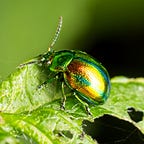Insect Photography: Spider Expedition
When shooting insects with an expert you get amazing shots
I followed a mini-course on spiders and part of the course was an expedition with a spider expert (David Seis) to find and photograph some spiders ourselves. With a group of nine people, we went to a favorite location of David and managed to find close to twenty different species. (Unfortunately, most of them do not have English names.) But photographing spiders is not easy.
The area we went to is dry with a lot of sand and heat. It is called the Beekhuizerzand near Harderwijk in the Netherlands. As a result, you expect to find spiders that live in dry and sandy areas. So you can find species here that normally live in the dunes near the sea.
Jumping spiders
Jumping spiders are probably the most beautiful spiders to photograph. They have a large head with large eyes. They don’t use a web so there is less distraction in the image. But they are small and they tend to run around all the time. So it is really hard to photograph them under the desired angle and get the eyes sharp. Automatic focus helps here. You can also use a burst of continuous shots to get one hopefully sharp, but I do not like that approach.
We saw two different jumping spiders during the expedition. The rare species at the start of this article and another one at the end. Both were caught by our expert and then released on some concrete block, where we had a few seconds to get the shots, before they ran away.
The web
The web is clearly an important aspect of spiders, although there are many spider species that do not build webs at all, like the jumping spiders. But most spider webs look rather ugly. So when you photograph a spider in its web, you have to pay extra attention to that web. In particular, when you are using a flash, the wires in the web become very white, while the background becomes almost black. When the web is nicely shaped, this can be an asset of the photo.
But often the web is not so nice, like in the image below. In this case you can use post-processing to reduce the highlights and whites in the area outside the spider. Don’t overdo it though. It looks unnatural when the spider is floating in space. Just make sure the attention of the viewer is drawn to the spider and that its shape or patterns dominate the scene.
Camouflage
Many spiders are difficult to spot. They look a lot like the plants they are sitting on. Green spiders for example sit on green leaves. Or the legs of the spider look like little stems of the plant. If they don’t move it is extremely difficult to see them.
To find such camouflaged spiders you need an expert to point them out. For example, the spider in the image below was sitting on a tree trunk. Some participants did not even see the spider when pointing a finger at it from a 10-centimeter distance.
Camouflaged spiders are easier to photograph, once you find them. They trust their camouflage and stay still. In post-processing, you might want to emphasize the spider a bit by locally adding some vibrance to the colors or some dynamic contrast. I did that in the image below, so the spider can be seen more easily than in real life.
Composition
As for all types of photography, composition helps to make your image more interesting. This is not easy to achieve. Most of the time you have no control over where the spider is sitting and there are often a lot of distractions around it. But by trying to take pictures from many different angles and by using some post-processing to improve composition and remove distractions, you can get better shots.
In the image below it was important that the cricket-bat shape is clearly visible, so I decided to put that in the center. The three little flowers provide a nice environment while there is a lot of negative space around it to draw attention to the center.
Another example is this shot of a Gibbaranea gibbosa spider, that has two characteristic bumps on its body. In the photo below I took an angle such that the two bumps are just above the edge of the little branch, putting some extra accent on them, while still keeping the eyes visible. By placing the spider in the center I emphasized the symmetry.
Colors and patterns
Some spiders have nice colors, while others have beautiful patterns on their back. Obviously you want to show these in your pictures. Try to have the spider on a background with a contrasting color, although it is hard to get the spider to go where you want. When a spider has a nice back pattern, try to use a background that is not distracting or use a flash to make the spider lighter and the background darker, as I used in the photo of the cricket-bat orbweaver above.
Conclusions
As with all insects, the most difficult part of photographing them is to find them. It really helps if you can go out with an expert that knows what to look for and where. But with spiders, even when you find then, they are often hard to photograph in nice ways. They can sit in locations with lots of distractions and it is difficult to get a good angle where you can, for example, see the eyes. But the results can be great. Let me end with another jumping spider we found during the expedition. These spiders are so nice with their big eyes.
Mark Overmars is a dedicated insect photographer who loves to share and regularly publishes about his work. You can visit his website at www.insectphotography.org. Download his free insect photography book at www.insectphotography.org/book.
